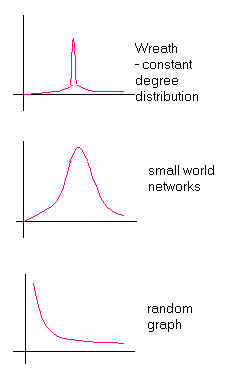Discussion Notes
Feb 21, 2001
(courtesy Ali A Zafer)Small-World Networks: WS Models
- starts with a lattice (wreath) which has a high
characteristic length and moves towards a random
graph through random rewiring. It is important to realize how
the careful choice of both the extremes allows the authors
to attribute the only cause of length reduction to the newly
introduced random links.

- To see why this is so delicate, consider
another possible kind of rewiring - a preferential
rewiring. In this situation, certain nodes have a higher propensity
of being linked to. An example of a graph with preferential
rewiring is given below:
Lets try to interpolate between the wreath (as the left extreme) and the celebrity graph (at the right extreme). The length reduction comparison in shown below:

As can be seen, in the small p range, the preferential rewirings are virtually indistinguishable from the random rewirings, so the length drops down to similar levels. Only at the high p-range is the difference more stark. It is thus unclear what a good base structure should be to explore the role of preferential links.
Aspects of small-world-ishness not captured by the WS model:
- Types of links
- Growth and death of links
- Average degree distribution (see below) doesn't really reflect
realistic small-world distributions (notice the authors' assumption
of a constant degree for every node). As p increases, the following
changes can be seen:
As the rewiring probability increases, the hump manifests itself as the Poisson threshold for a random graph. In many real datasets, the degree distribution looks like a power law.
- Why people are actually adept at finding short-paths through the network in a distributed manner (some impossibility results from Kleinberg)
Exploiting Small-World Networks
- Adamic's idea of designing smarter search engines; idea needs to be developed further. Do all distances lie between 2 and 3 (see tables in the paper?)
- Gossip spreading
- QoS guarantees in networking
Summary
- mostly a cute model of observed real-life phenomena.
- results primarily simulation-based. Rigorous mathematical
results are only coming out.
